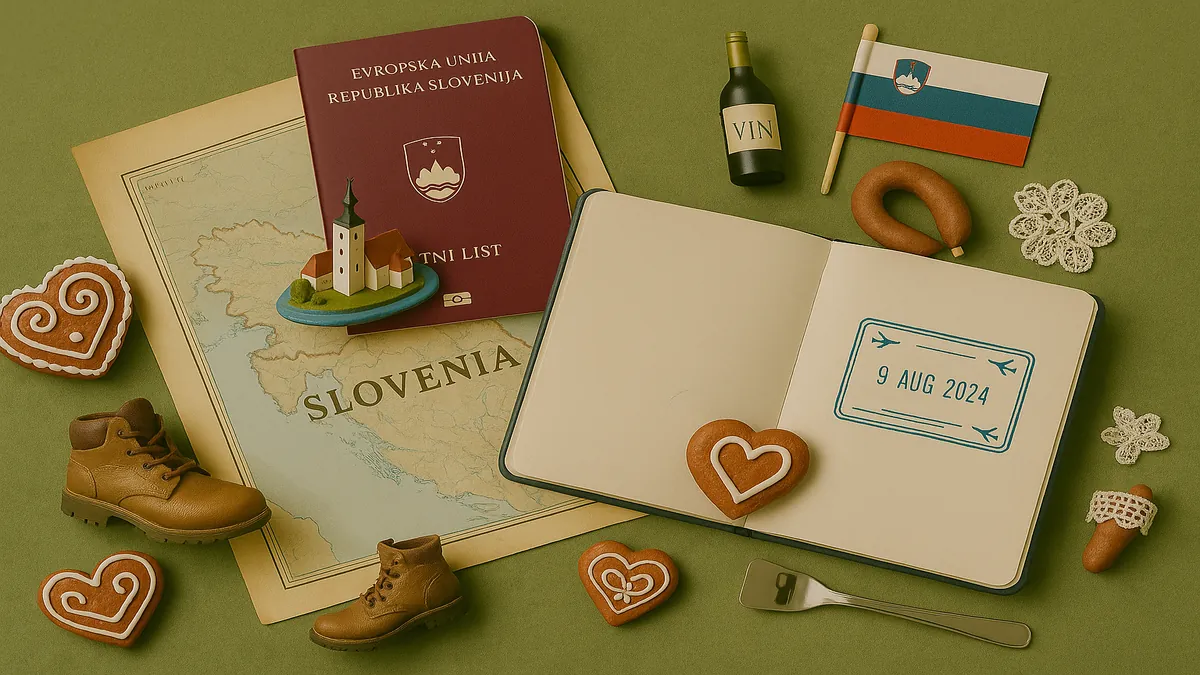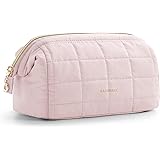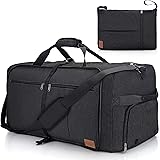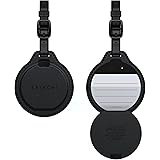Planning your first adventure to Slovenia in 2025? You’ve picked one of Europe’s most enchanting and greenest destinations! This ultimate guide is packed with everything you need to know to make your trip unforgettable. From exploring the fairytale shores of Lake Bled to wandering through the vibrant capital of Ljubljana and discovering vast underground caves, we’ve got you covered.
Slovenia, the jewel nestled between the Alps and the Adriatic, offers a spectacular blend of breathtaking nature, charming cities, and a warm, welcoming culture. It’s a country that captivates every traveler, whether you’re hiking in the Julian Alps, kayaking on emerald rivers, or simply savoring delicious, locally-sourced food in a riverside cafe.
Get ready to discover why Slovenia has become one of Europe’s most sought-after travel destinations. Let’s dive into the 15 essential tips that will help you plan, budget, and experience the very best of this amazing country.
Table of Contents
- 1. Why Visit Slovenia in 2025?
- 2. Best Time to Visit Slovenia
- 3. Top Destinations in Slovenia for First-Timers
- 4. Planning Your Slovenia Trip: A Step-by-Step Guide
- 5. Accommodation in Slovenia: Where to Stay
- 6. Getting Around Slovenia: Transportation Guide
- 7. How Much Does a Trip to Slovenia Cost?
- 8. Must-Try Foods and Cultural Delights
- 9. Staying Safe in Slovenia
- 10. Solo Travel in Slovenia
- 11. Traveling Slovenia with Family or as a Senior
- 12. Digital Nomads in Slovenia
- 13. Essential Packing List in our Slovenia Travel Guide
- 14. FAQs for First-Timers
- 15. What’s Next? More Guides to Explore
1. Why Visit Slovenia in 2025?
Slovenia is a land of captivating beauty and endless charm. In 2025, it stands out as a top choice for travelers seeking authentic experiences, stunning nature, and outdoor adventure, all within a compact and easily navigable country. Its unique blend of Alpine, Mediterranean, and Pannonian influences makes it truly special.
The Allure of Europe’s Green Heart
Imagine rowing a traditional pletna boat to the iconic island on Lake Bled, exploring the vast underground world of Postojna Cave, or hiking through the pristine Triglav National Park. Slovenia offers all this and more. The country boasts an incredibly safe and clean environment, a deep commitment to sustainability, and a rich cultural heritage.
From the vibrant, pedestrian-friendly capital of Ljubljana to the charming coastal town of Piran, Slovenia promises a journey filled with unforgettable moments. It’s a place where every landscape feels like a postcard, and every adventure is just a short drive away.
ETIAS Update for 2025
Good news for travelers! The European Travel Information and Authorization System (ETIAS) is still not required for U.S. and other visa-exempt travelers visiting the Schengen Area in 2025. Its implementation has been postponed to mid-2026. This means your entry to Slovenia, a member of the Schengen Area, will be as straightforward as it has been in previous years.
Looking for the best hotel or flight deals?
Plan your trip with ease using the Expedia search tool below. From charming boutique hotels to luxury resorts, this widget helps you compare top options in seconds — flights included!
2. Best Time to Visit Slovenia
Choosing the right time to visit Slovenia can significantly enhance your experience. The country has four distinct seasons, each offering unique charms for different types of activities.
Spring (April-May): Blooming Landscapes & Fewer Crowds
- Weather: Cool and crisp, with temperatures from 10-20°C (50-68°F). Perfect for sightseeing as nature awakens.
- Crowds: Fewer crowds than summer, making it ideal for exploring popular spots like Lake Bled and Ljubljana.
- Pros: Landscapes are lush and green, wildflowers are in bloom. The weather is comfortable for city exploration and low-altitude hiking. Prices for accommodation are lower.
- Cons: The weather can be unpredictable with spring showers. Higher mountain passes may still be closed.
Summer (June-August): Peak Season for Outdoor Adventures
- Weather: Warm and sunny, with temperatures often reaching 25-30°C (77-86°F).
- Crowds: Peak tourist season. Lake Bled, Ljubljana, and the coast are busy.
- Pros: Best weather for swimming, hiking in the Julian Alps, kayaking, and all outdoor activities. All mountain passes are open. Numerous festivals and events.
- Cons: Can be crowded and more expensive. Book everything well in advance.
Autumn (September-October): Golden Hues & Hiking
- Weather: Mild and often beautiful, especially in September, with temperatures from 15-22°C (59-72°F).
- Crowds: Crowds begin to thin out significantly after the first week of September.
- Pros: Stunning autumn foliage makes it a beautiful time for hiking. It’s also wine harvest season in regions like Goriška Brda. The weather is still pleasant for sightseeing.
- Cons: Days get shorter, and it can be rainy and cool, especially in October.
Winter (November-March): Snowy Fairytale & Skiing
- Weather: Cold and often snowy, with temperatures from -5 to 5°C (23-41°F).
- Crowds: Very few tourists outside of ski resorts.
- Pros: Lake Bled covered in snow is a true fairytale. Excellent for skiing and other winter sports in resorts like Kranjska Gora. Ljubljana has a charming Christmas market.
- Cons: Very short daylight hours. Many rural attractions may be closed. Driving can be challenging.
Recommendation for First-Timers: For the perfect balance of great weather for outdoor activities and manageable crowds, aim for June or September. For beautiful colors and fewer people, choose late September or early October.
Make Your Travel Moments Go Viral — Instantly
Your next viral Reel and Tiktok is just a Flipstik away. Film hands-free on buses, beaches, or balconies—anywhere your phone can stick.
🎯 Click here and gear up like a creator!3. Top Destinations in Slovenia for First-Timers
For a country so compact, Slovenia is packed with diverse and world-class destinations. Here are the must-visit spots for your first trip.
Ljubljana: The Charming Green Capital
Winner of the European Green Capital award, Ljubljana is one of Europe’s most charming and livable cities. Its car-free city center is perfect for exploring on foot, with the emerald-green Ljubljanica River flowing through its heart. Visit Ljubljana Castle for panoramic views, walk across the iconic Dragon Bridge, and enjoy the lively cafe culture.
Lake Bled: The Fairytale Island
The absolute icon of Slovenia. Lake Bled is a stunning glacial lake with a picturesque church on a tiny island in the middle, all overlooked by a medieval castle perched on a cliff. You can row a boat to the island, hike to viewpoints like Ojstrica for the classic photo, and try the famous Bled cream cake (kremšnita).
Triglav National Park: The Julian Alps
Slovenia’s only national park is a paradise for nature lovers and hikers. It’s home to the majestic Julian Alps, including Mount Triglav, the country’s highest peak. Explore stunning areas like Lake Bohinj (Bled’s larger, more rustic neighbor), the Vintgar Gorge, and the Soča Valley, famous for its emerald-green river.
Piran: A Slice of Venice on the Adriatic
This beautiful town on Slovenia’s short but sweet coastline feels like a miniature Venice. With its narrow medieval streets, a main square that opens onto the sea, and a beautiful hilltop church, Piran is a perfect spot to enjoy the Mediterranean atmosphere. Climb the bell tower for breathtaking views of the red-roofed town.
Postojna Cave & Predjama Castle
Discover Slovenia’s incredible underground world at Postojna Cave, one of the largest karst cave systems in the world. A unique electric train takes you deep into the cave to see its magnificent formations. Just a few kilometers away is the incredible Predjama Castle, a medieval fortress built into the mouth of a cave.
4. Planning Your Slovenia Trip: A Step-by-Step Guide
Planning your first trip to Slovenia is exciting! Its small size makes it relatively easy to plan, but breaking it down into steps makes the process even smoother.
Setting Your Budget & Travel Style
First, decide on your budget. Slovenia is more affordable than its neighbors Italy and Austria but slightly more expensive than other Balkan countries. Decide if you want an adventure-packed trip in the Alps, a relaxing city break, or a mix of everything.
Crafting Your Itinerary
Don’t try to rush. For a 3-4 day trip, focus on Ljubljana and a day trip to Lake Bled. With a week, you can easily add Triglav National Park (Soča Valley) and the coast (Piran). A car is highly recommended for flexibility, as it allows you to see much more in a shorter time.
Booking Flights & Accommodation
Book flights 3-6 months in advance for the best prices. The main airport is Ljubljana Jože Pučnik Airport (LJU). Book accommodation well in advance for July and August, as the best places in popular areas fill up quickly.
Understanding Visa & Entry Requirements
For most nationalities (e.g., US, UK, EU, Canadian, Australian citizens), a visa is not required for tourist stays of up to 90 days. Always ensure your passport is valid for at least six months beyond your intended departure date.
Securing Travel Insurance
This is non-negotiable, especially if you plan on outdoor activities like hiking. Get comprehensive travel insurance that covers medical emergencies, trip cancellations, and any adventure sports you plan to do.
5. Accommodation in Slovenia: Where to Stay
Slovenia offers a fantastic range of accommodation, from modern city hotels to charming farm stays, with options for every budget.
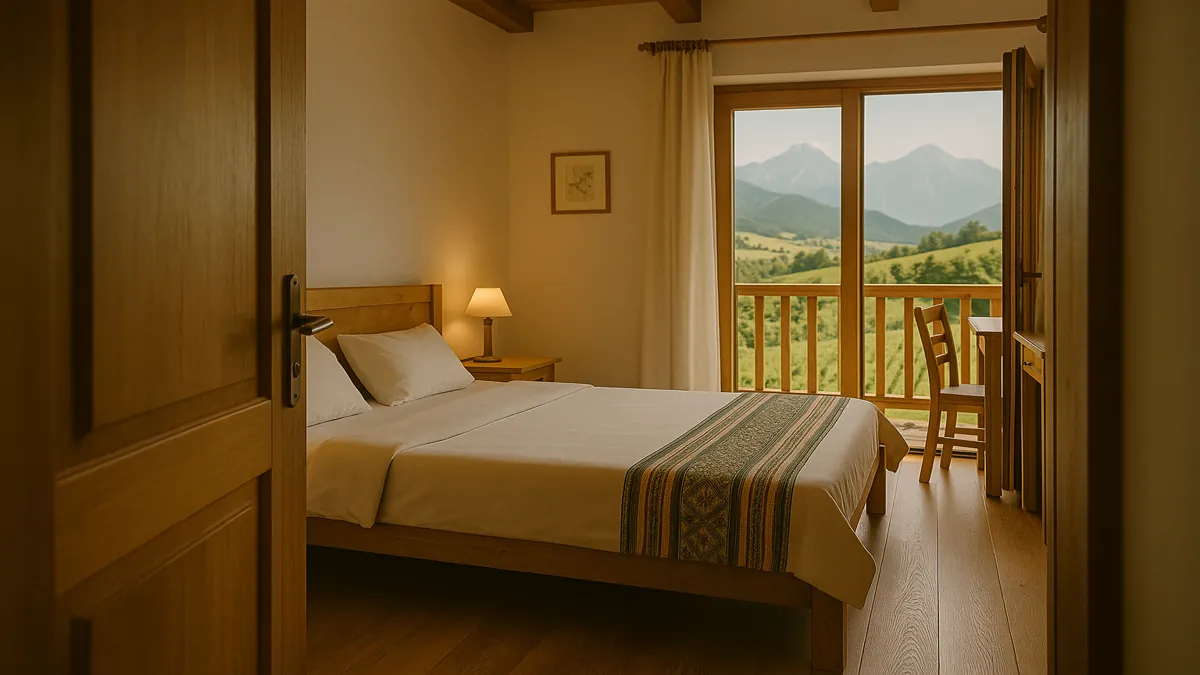
Hotels: From City Boutiques to Spa Resorts
You’ll find a wide variety of hotels, from modern boutique hotels in Ljubljana’s city center to lakeside resorts in Bled. Quality is generally high, and many places focus on sustainability and local character.
Apartments & Guesthouses: The Local Choice
This is a very common and often best-value type of accommodation, especially outside the capital. Privately owned apartments (apartma) and guesthouses (penzion) offer a more personal, often family-run, experience.
Tourist Farms (Turistična kmetija): Nature & Authenticity
For a unique and highly recommended experience, stay at a tourist farm. This is a great way to experience Slovenian hospitality, enjoy incredible home-cooked meals made from local produce, and immerse yourself in the country’s beautiful nature. They are perfect for families and those seeking an authentic escape.
Hostels: Social & Budget-Friendly
Hostels are common in Ljubljana, Bled, and other tourist hubs. They are perfect for solo travelers and those on a tight budget. Many are modern, clean, and offer a mix of dorm beds and private rooms.
Glamping & Mountain Huts
Slovenia has a booming glamping scene, offering unique stays in luxury tents and wooden cabins. For serious hikers, staying in a mountain hut (planinska koča) in the Julian Alps is an unforgettable experience, but you must book far in advance.
6. Getting Around Slovenia: Transportation Guide
Slovenia is a small and very well-connected country, making it easy to explore. Here’s how to navigate it.
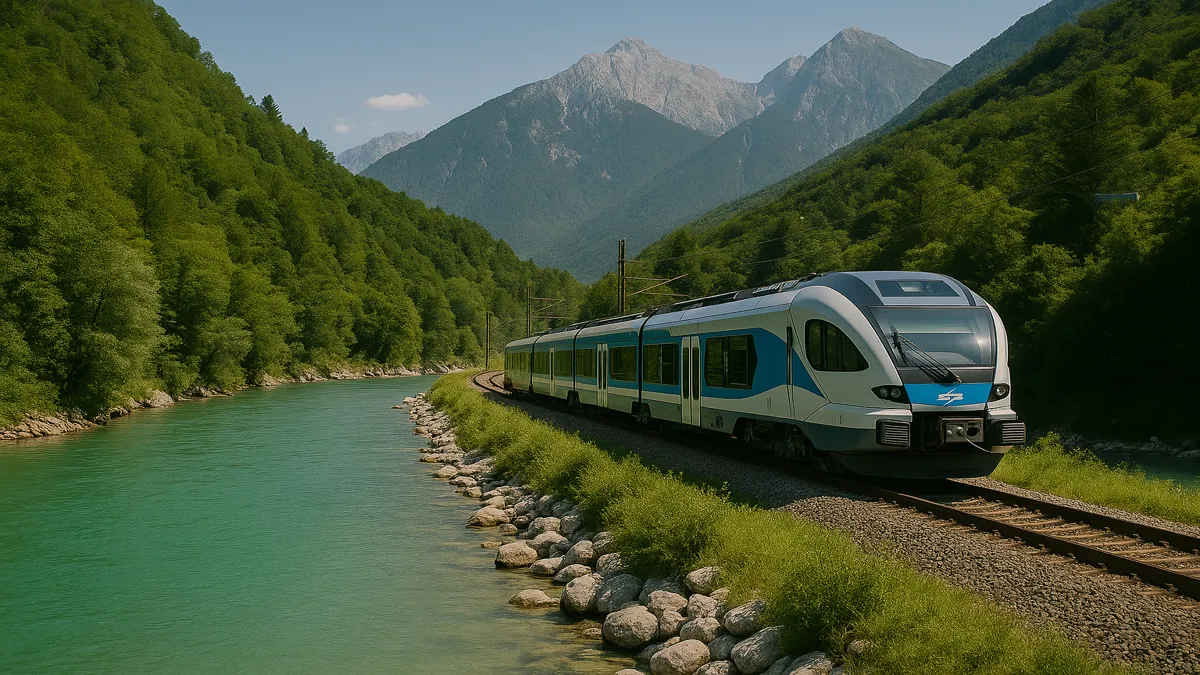
Driving (Car Rental): The Best Way for Flexibility
- Pros: A rental car gives you the ultimate freedom and is the highly recommended way to see Slovenia. It allows you to explore the national parks, scenic drives (like the Vršič Pass), and smaller towns at your own pace. Roads are excellent and well-signposted.
- Cons: Not necessary if you are only staying in Ljubljana. Parking in the city center can be expensive.
- Tips: You must purchase a “vignette” (a toll sticker) for driving on motorways. Rental cars should already have one.
Buses: Affordable & Extensive
- Pros: The bus network is modern, comfortable, and extensive, connecting all major towns and even smaller villages. It’s the main form of public transport for intercity travel if you don’t have a car.
- Cons: Can be slower than driving and less frequent on weekends or to more remote areas.
- Booking: You can check schedules online (Avtobusna postaja Ljubljana) and usually buy tickets from the driver or at the station.
Trains: Limited but Scenic
- Pros: The train network is modern and efficient, offering scenic rides, especially the route from Jesenice to Nova Gorica through the Alps.
- Cons: The network is less extensive than the bus network and doesn’t serve many key tourist areas like the Soča Valley or Piran directly.
Public Transport in Ljubljana
- Pros: Ljubljana’s city center is largely pedestrianized. For longer distances, the bus network is excellent.
- Tip: You’ll need an Urbana card to use the buses, which you can buy and top up at kiosks.
Ready to book your train tickets hassle-free?
Search routes and compare prices on Trainline – your one-stop platform for rail travel across Europe.
7. How Much Does a Trip to Slovenia Cost?
Slovenia offers excellent value for money, sitting comfortably between the cheaper prices of the Balkans and the higher costs of Western Europe. It’s an affordable destination where high quality doesn’t always mean a high price.
Daily Cost Estimates (Per Person)
- Budget Traveler: €45-€70 / $50-77 USD per day
- Accommodation: Hostel dorms, basic guesthouses.
- Food: Supermarket meals, bakeries, cooking your own food.
- Transport: Public buses, walking.
- Activities: Free activities like hiking, exploring cities on foot.
- Mid-Range Traveler: €80-€150 / $88-165 USD per day
- Accommodation: Mid-range hotels, well-located apartments, tourist farms.
- Food: Eating out at casual restaurants (gostilna), cafes.
- Transport: Rental car (split between travelers), intercity buses.
- Activities: Paid attractions like caves, castles, guided tours.
- Luxury Traveler: €180+ / $200+ USD per day
- Accommodation: Luxury hotels, boutique hotels, high-end glamping.
- Food: Fine dining, wine tasting menus.
- Transport: Private transfers, premium car rental.
- Activities: Private tours, adventure sports with guides.
Money-Saving Tips:
- Eat at a “Gostilna”: These are traditional inns serving hearty, delicious, and affordable local food. Look for their daily lunch specials (“malice” or “kosilo”).
- Enjoy Nature: Most of Slovenia’s best attractions—its mountains, rivers, and forests—are completely free to explore.
- Drink Tap Water: The tap water is of excellent quality and perfectly safe to drink throughout the country. It’s one of the best in Europe!
- Rent a Car (for groups): While an upfront cost, splitting a car rental between 2 or more people is often cheaper and more efficient than relying on public transport.
- Shop at Supermarkets: Chains like Mercator and Hofer (Aldi) are great for affordable groceries, snacks, and drinks.
8. Must-Try Foods and Cultural Delights
Slovenian cuisine is a delightful surprise, drawing influences from its Italian, Austrian, Hungarian, and Balkan neighbors. It’s a “farm-to-table” culture focused on fresh, local, and seasonal ingredients.
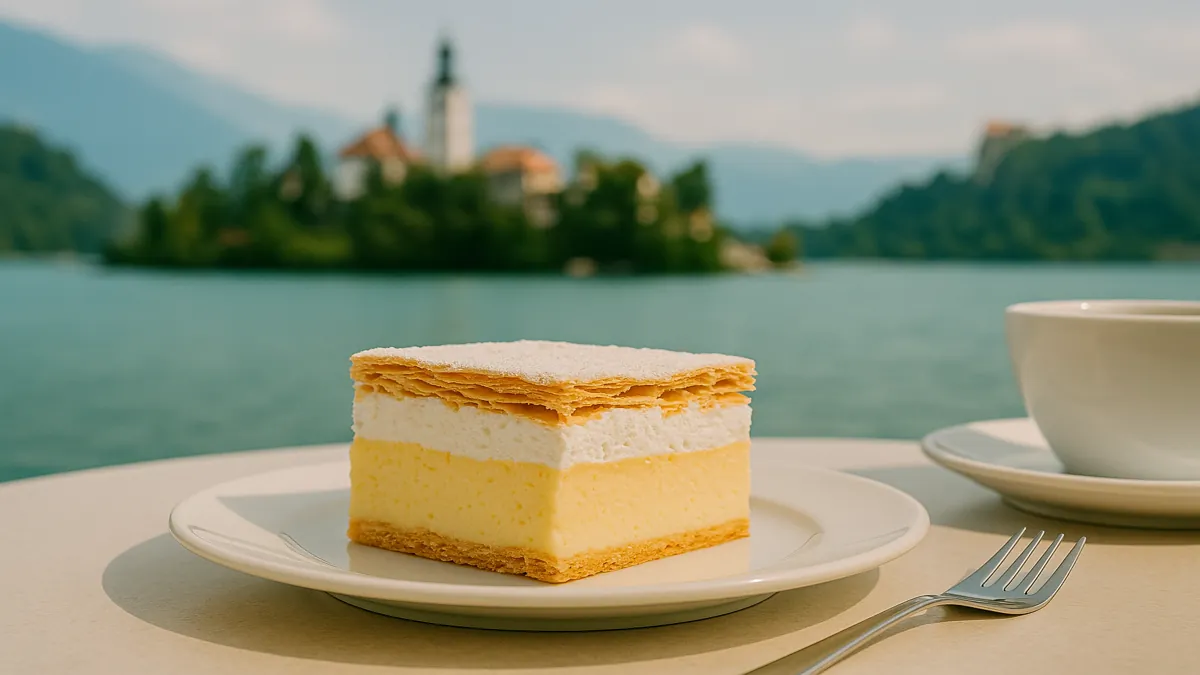
Iconic Slovenian Dishes
- Kranjska Klobasa (Carniolan Sausage): A protected national treasure, this pork and bacon sausage is a must-try, often served with mustard and a bread roll.
- Idrijski Žlikrofi: Small potato-filled dumplings, often served as a side dish or a main course topped with sauce or crispy bacon bits.
- Ajdovi Žganci: A hearty buckwheat spoonbread, a rustic staple often served with cracklings, milk, or as a side to stews.
- Jota (Yota): A thick, hearty soup made with beans, sauerkraut or sour turnip, potatoes, and often smoked pork. Perfect after a day of hiking.
- Bled Cream Cake (Kremšnita): The famous dessert from Lake Bled. A wobbly tower of vanilla custard and whipped cream between layers of crispy puff pastry.
- Potica: A traditional rolled pastry, typically filled with a sweet walnut paste, but can have dozens of other fillings. A staple at holidays and celebrations.
The Outdoor Culture
Slovenians have a deep connection to the outdoors. Hiking isn’t just a hobby; it’s a way of life. On weekends, you’ll find people of all ages heading to the mountains. Embracing this outdoor spirit is key to understanding the local culture.
Cultural Etiquette & Local Customs
- Reserved but Friendly: Slovenians can seem reserved at first, but they are very friendly, hospitable, and helpful once you engage them.
- Punctuality: Being on time for appointments is valued.
- Greetings: A simple “Dober dan” (Good day) is a polite greeting.
- Tipping: Tipping is not obligatory or widely expected, but rounding up the bill or leaving 5-10% for excellent service in a restaurant is a nice gesture and becoming more common.
9. Staying Safe in Slovenia
Slovenia is consistently ranked as one of the safest countries in the world. Crime rates are very low, and it’s a very safe destination for tourists. The main safety concerns are related to outdoor activities.
General Safety Tips
- Petty Crime: While very rare, take normal precautions in crowded tourist areas in Ljubljana.
- Driving Safety: Roads are excellent, but be cautious on winding mountain roads like the Vršič Pass. Adhere to speed limits strictly.
Hiking and Outdoor Safety
- Be Prepared: The weather in the mountains can change in an instant. Even in summer, bring layers, a waterproof jacket, and sturdy hiking boots.
- Check Conditions: Always check the weather forecast and trail conditions before setting out. Some trails can be dangerous or closed due to snow, even in early summer.
- Inform Someone: Let someone know your planned route and expected return time.
Emergency Numbers
- The universal emergency number in Slovenia is 112 for police, ambulance, and fire services. For mountain rescue, this is also the number to call.
10. Solo Travel in Slovenia
Slovenia is a fantastic and extremely safe destination for solo travelers. It’s affordable, easy to get around (especially with a car), and its compact size makes it manageable. The excellent hostel scene in Ljubljana and Bled makes it easy to meet other people.
The country’s incredible safety record and the helpfulness of locals allow for stress-free independent exploration. Joining a guided day tour for activities like canyoning or kayaking in the Soča Valley is a great way to see nature and connect with fellow travelers.
11. Traveling Slovenia with Family or as a Senior
Slovenia’s diverse offerings, safety, and cleanliness make it an excellent choice for both families and seniors.
Traveling with Family
- Outdoor Fun: The country is a giant playground. Families will love the easy walks around Lake Bled and Lake Bohinj, the train ride in Postojna Cave, and exploring medieval castles.
- Accommodation: Renting an apartment or staying at a tourist farm is ideal for families, providing space, kitchen facilities, and often outdoor play areas.
- Pacing: The country is small, so driving times are short, making it easy to travel with children without long, boring journeys.
Traveling as a Senior
- Accessibility: Ljubljana’s flat, pedestrianized city center is very accessible. Be aware that popular spots like Bled Castle and Predjama Castle involve stairs and steep walks.
- Pace: Opt for a slower pace. Choose fewer destinations and spend more time in each to avoid rushing. Consider guided tours that handle logistics.
- Safety and Comfort: The country is very safe, and the high quality of services makes for a comfortable trip. Driving is straightforward outside of the city center.
12. Digital Nomads in Slovenia
Slovenia is a rising star for digital nomads, offering an incredible quality of life, fast internet, and a prime location in the heart of Europe.
- Digital Nomad Visa: While Slovenia doesn’t have a specific “digital nomad visa” yet, EU citizens can live and work freely. Non-EU citizens can typically stay for 90 days on a tourist visa, and many explore other long-stay options if they wish to remain. The situation is evolving, so always check official sources.
- Best Cities for Nomads:
- Ljubljana: The undisputed hub. It has a vibrant, international feel, numerous co-working spaces (like Poligon), a great cafe culture, and a high quality of life.
- Maribor: Slovenia’s second city offers a more relaxed vibe and a lower cost of living, set in a beautiful wine-growing region.
- Connectivity: Internet is famously fast, reliable, and widespread.
- Cost of Living: Very reasonable for the quality of life offered. It’s more affordable than neighboring Italy or Austria.
- Lifestyle: The main draw is the work-life balance. It’s easy to finish work and be hiking in the mountains or swimming in a lake within an hour.
Looking for a smarter way to manage your travel money? Wise offers real exchange rates with no hidden fees, making it the perfect companion for international trips.
13. Essential Packing List in our Slovenia Travel Guide
Packing for Slovenia is about preparing for outdoor adventures and changeable weather. Versatility and layers are key.
Clothing
- Waterproof/Windproof Jacket: Absolutely essential for any season, as rain showers can be sudden, especially in the mountains.
- Layers: T-shirts, long-sleeved tops, and a fleece or wool sweater are crucial for adapting to temperature changes between the valleys and mountains.
- Comfortable Walking Shoes/Hiking Boots: You’ll be walking a lot. Proper hiking boots are a must if you plan to do any serious trails in the Alps.
- Warm Gear (for winter): A proper winter coat, thermal underwear, warm hat, gloves, and a scarf are non-negotiable for a winter trip.
- Swimwear: For summer dips in the lakes, rivers, or the Adriatic Sea.
- Slightly Dressier Outfit: For a nice dinner or a night out in Ljubljana.
Essentials & Accessories
- Universal Travel Adapter: Slovenia uses Type F plugs (two round pins).
- Reusable Water Bottle: To stay hydrated with the country’s pristine tap water.
- Daypack: Essential for daily excursions and hikes.
- Sunscreen & Sunglasses: The summer sun can be strong, especially at higher altitudes.
- Insect Repellent: For summer, especially if you plan to be near forests or water.
As an Amazon Associate, we earn from qualifying purchases.
14. FAQs for First-Timers
Here are some frequently asked questions to help you plan your first trip to Slovenia.
What currency does Slovenia use?
Slovenia uses the Euro (€). It officially joined the Eurozone in 2007.
Is English widely spoken?
Yes, English proficiency is excellent, especially among younger people and in the tourism industry. You will have no problem communicating in tourist areas, hotels, and restaurants.
Is Slovenia expensive?
Slovenia is moderately priced. It’s more affordable than Austria and Italy but more expensive than countries like Croatia or Hungary. It offers great value for the quality and experiences on offer.
Do I need a visa for Slovenia in 2025?
For most nationalities (e.g., US, UK, EU, Canadian, Australian), a visa is not required for tourist stays up to 90 days as Slovenia is in the Schengen Area.
What is the best way to get around?
Renting a car is the best and most flexible way to see the country, especially for exploring the national park and countryside. The intercity bus network is a good alternative if you don’t want to drive.
Is Ljubljana the only place worth visiting?
While Ljubljana is a wonderful capital, Slovenia’s main attractions are its natural landscapes. The true magic of the country is found at Lake Bled, Lake Bohinj, the Soča Valley, and in the mountains of Triglav National Park.
15. What’s Next? More Guides to Explore
Your Slovenian adventure awaits! We hope this comprehensive guide has equipped you with all the essential information to plan an unforgettable trip to Europe’s green heart. From the fairytale magic of Lake Bled to the pristine beauty of the Julian Alps, Slovenia promises a journey filled with discovery, adventure, and lasting memories.
Happy travels, and enjoy your unforgettable journey through Slovenia!
Related Articles to Inspire Your Next Adventure:
🇪🇺 Western Europe
🇪🇺 Southern Europe
🇪🇺 Northern Europe
🇪🇺 Central Europe
🇪🇺 Eastern Europe & Baltics
🌍 Continental Overview
References:
European Union. (2025, April 14). Revised timeline for the EES and ETIAS. Retrieved from Official EU Site
